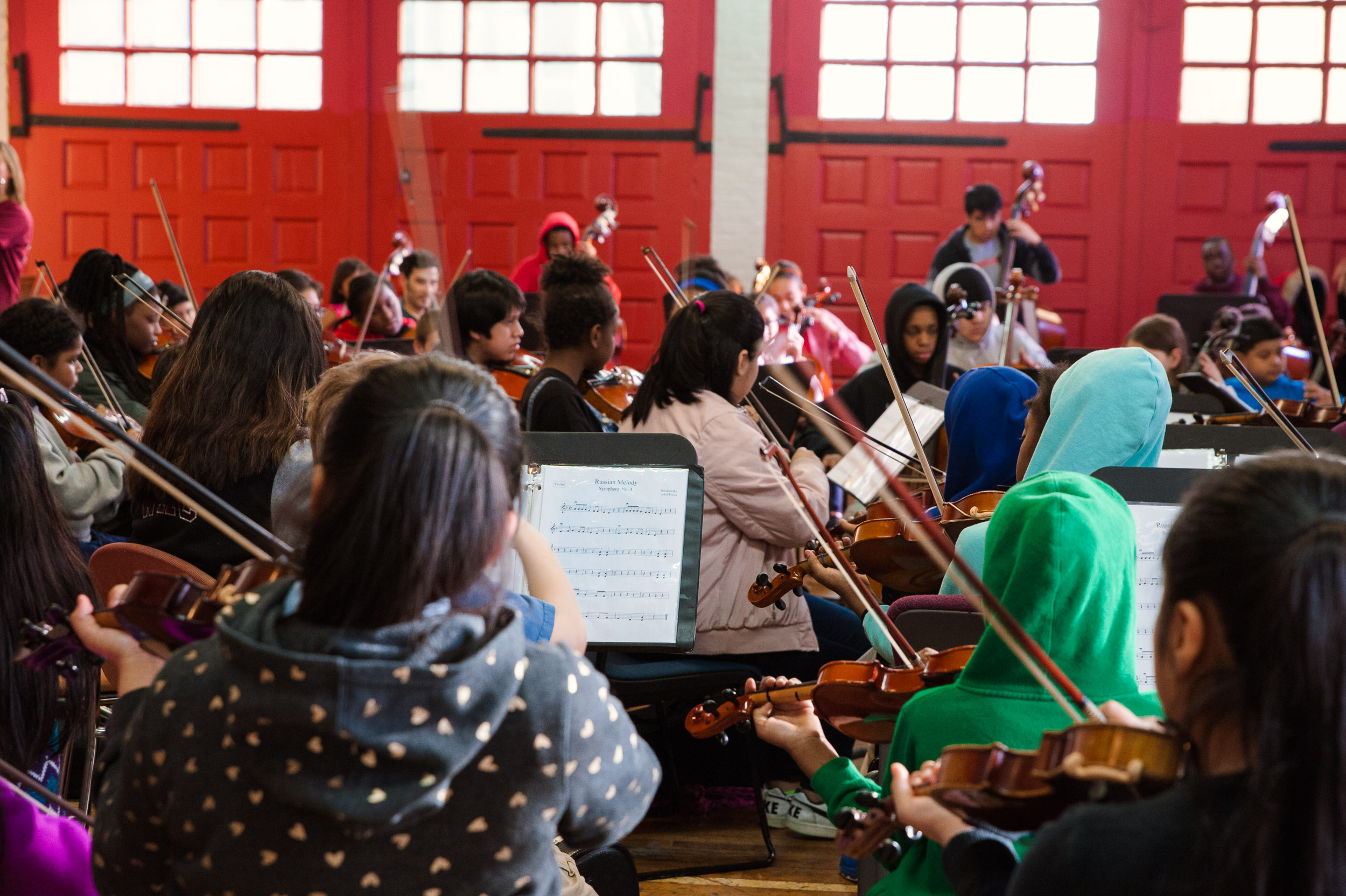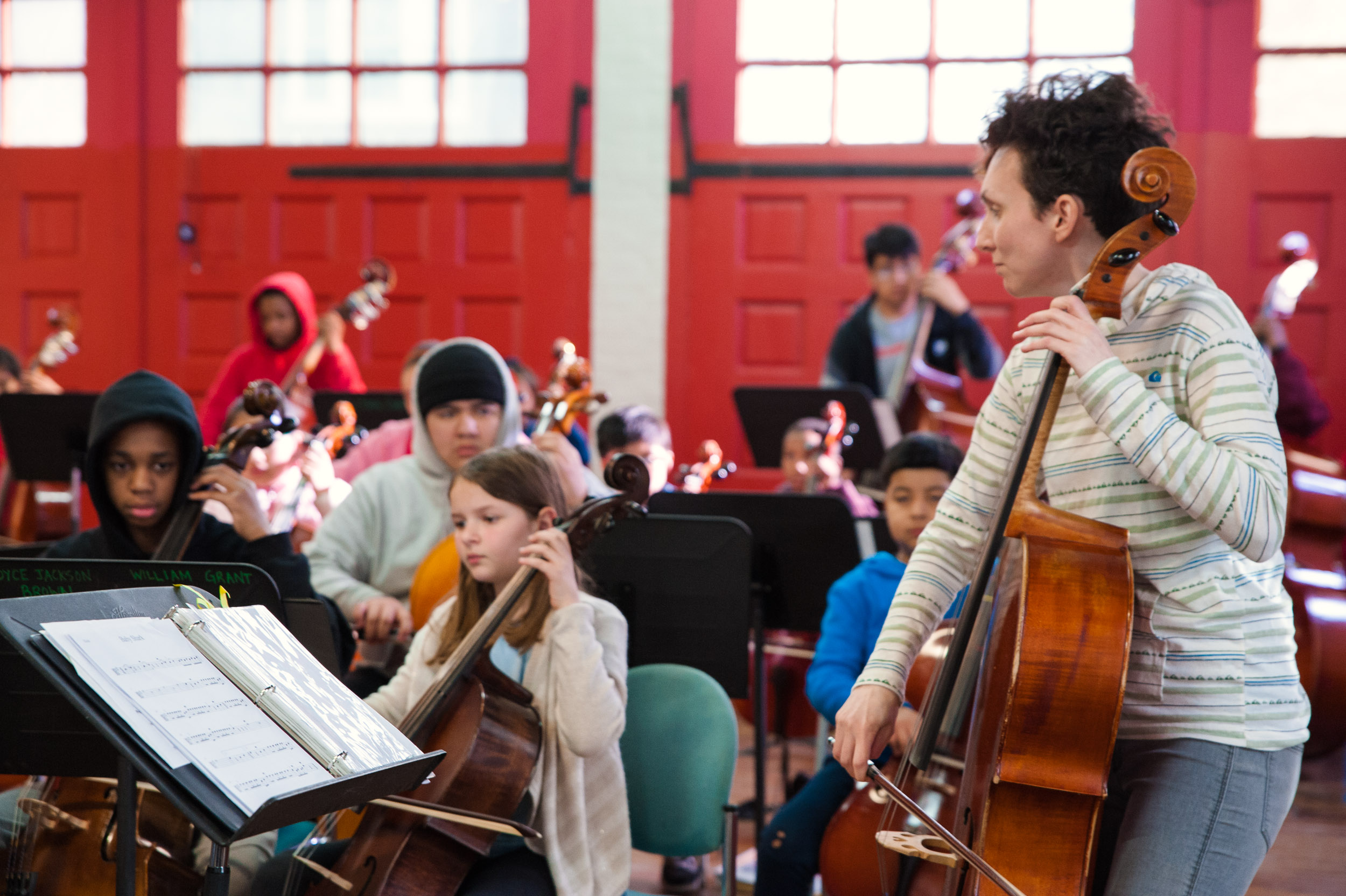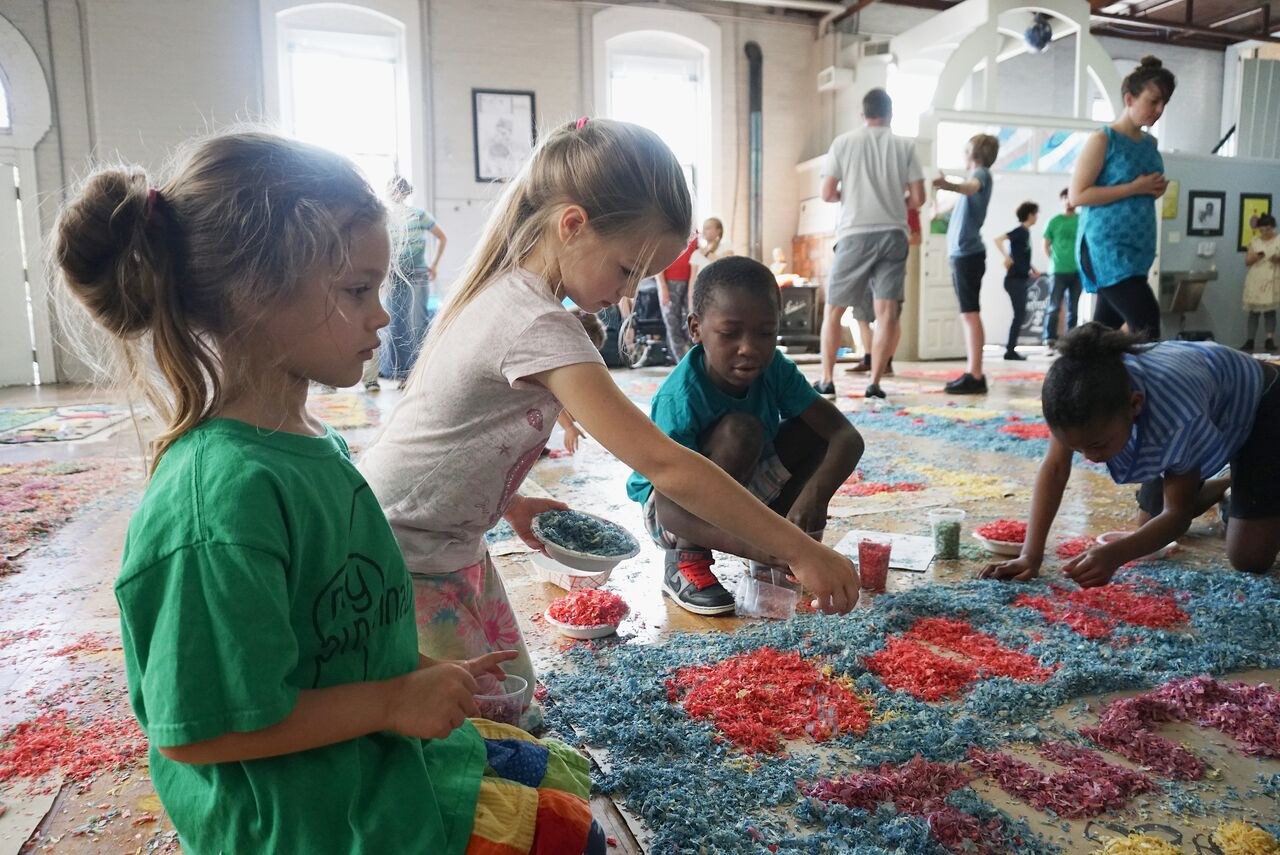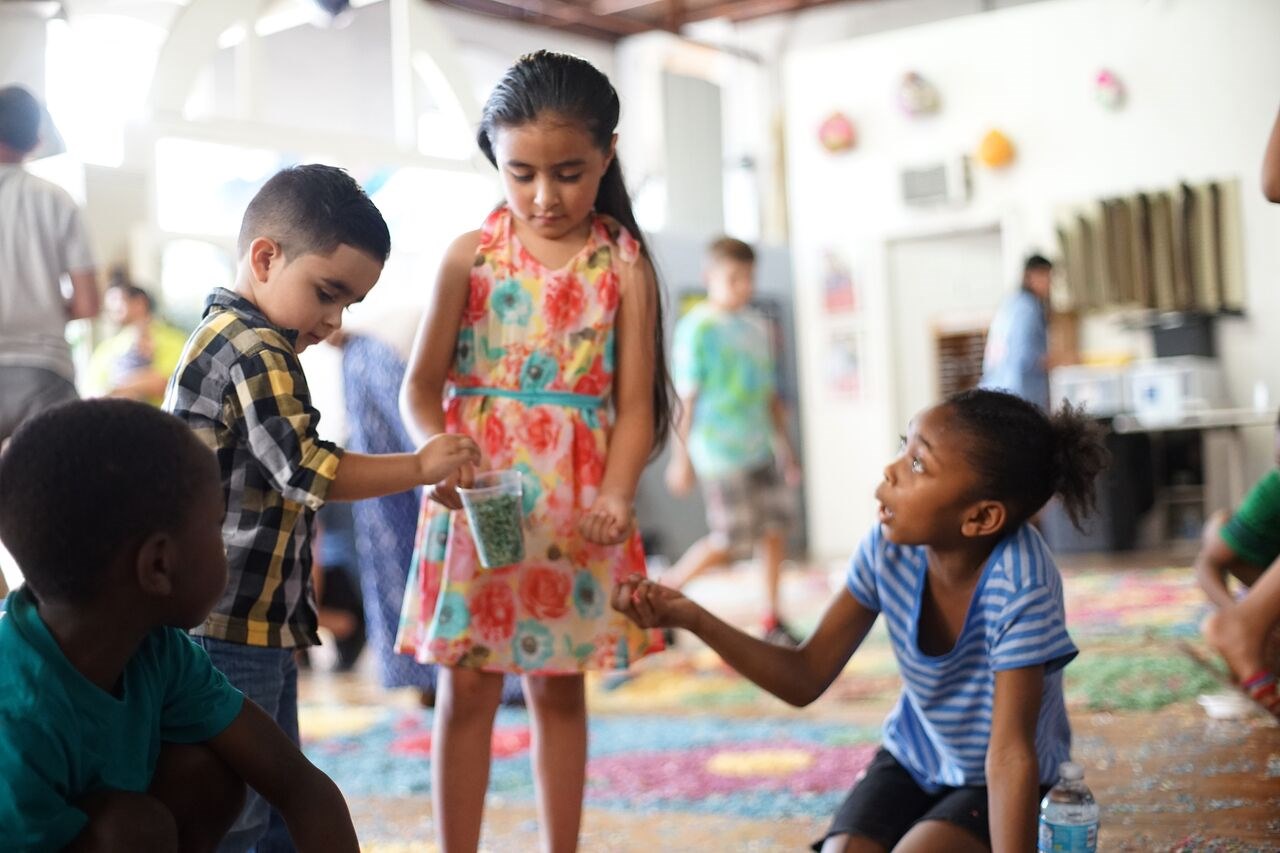This is the story of how a youth orchestra took root and flowered within a community development corporation, and has ended up helping transform a community and enriching a city. Music for Youth in Cincinnati—MyCincinnati—and the work of Price Hill Will are emblematic of the extraordinary power of home-grown arts and culture to leverage growth, connection and joy.
All images courtesy Price Hill Will.
[T]o sing and to play together means to intimately coexist toward perfection and excellence.
— Maestro José Abreu, founder of El Sistema
In 2011, the Cincinnati nonprofit Price Hill Will was busy doing what workhorse community development corporations do—strategizing to safeguard the community’s morale and built environment from a devastating wave of foreclosures, and reaching out to residents to make sure everyone had a voice in Price Hill’s future.
Then a young cellist, fresh from a prestigious fellowship at Boston’s New England Conservatory of Music, approached the organization’s executive director to propose a project that seemed way outside its core mission: classical music instruction and an orchestra for local kids. But soon, 11 children picked up their loaner instruments and began to produce the first rasps and squeaks of Music for Youth in Cincinnati (MYCincinnati).

What followed over the ensuing decade had a touch of magic in it—“wildly amazing” is how MYCincinnati founder Laura Jekel describes it. The music program grew to include more than a hundred neighborhood children playing string, percussion, and wind instruments and instructed by a dozen accomplished teaching artists five afternoons a week, at no charge to their families.
Music blossomed at the very heart of Price Hill Will. It became a medium for connecting residents of Cincinnati’s most racially and economically diverse neighborhood in joy, love, and rigorous practice. And it’s not a stretch to say that the energy of music-making, dovetailing with the strategic goals of community development, inspired the remarkable physical renewal unfolding today around the place where MYCincinnati kids practice and perform.
Last year, Price Hill Will completed a $10 million project that restored to glory a stately, long-disused Masonic Lodge, making it into a spacious performance and community space called ARCO (for arts and community). Now the organization has embarked on another $10 million development restoring eight historic buildings on a single block, including the handsome nineteenth-century redbrick firehouse that’s been MYCincinnati’s home for several years. This once forlorn stretch of urban turf will soon be a humming nexus of creative space for families, arts nonprofits, and community-serving businesses, with 13 affordable apartments on upper floors.
The idea that homegrown arts and culture can be harnessed to generate riches both intangible and material within disinvested communities is a defining tenet of creative placemaking, a movement born around the same time as MYCincinnati. Price Hill Will has pulled it off. And in doing so it helps illuminate a field of practice that’s tough to describe in a few words.
So what does Price Hill’s story tell us about creative placemaking? That it’s best seen as an ongoing practice and point of view, far outlasting the one or two years covered by a typical grant. That its benefits are hard to quantify (how do you draw a straight line from kids playing violin to $20 million in real estate investment?). That it’s markedly different from traditional arts philanthropy, or art for art’s sake alone. Finally, Price Hill’s experience underlines the fact that it’s impossible to prescribe just what creative placemaking should look like. To advance racial and economic justice, arts activities must engage the particular needs, dreams, and values of real people in particular places.
Price Hill’s life and times
Price Hill covers about six square miles of varied terrain, from Lower Price Hill, tucked in the river valley just west of downtown Cincinnati, to contiguous East Price Hill and West Price Hill, larger neighborhoods perched atop one of the city’s famous hills. After the 1870s construction of an “incline” railway to haul passengers up the hillside, the community burgeoned as a refuge from the city’s density and pollution, filling up, over the decades, with economically comfortable residents of German, Irish, Italian, and Appalachian extraction.

Unlike urban places around the country that saw economic decline and middle-class flight during the deindustrialization of the mid-twentieth century, Price Hill didn’t hit hard times until the 1990s and early 2000s. In the last 20 years, Price Hill has lost population and amenities like retail, and seen its share of vacancy and crime. Predatory landlords entered the scene, snapping up devalued real estate even before the historic foreclosure crisis that brought disproportionate suffering to Price Hill.
At the same time, a mix of new residents brought their aspirations to this affordable neighborhood—many more Black families, some of them displaced from other parts of Cincinnati, and a fast-growing population of immigrants from Honduras, Guatemala, and Mexico, mostly rural people fleeing drought, deprivation, and danger. People from African and Asian countries have made their home there, too.
Music enrichment with a difference
It takes a special classical music program to form the connective tissue in a diverse community. MYCincinnati is based on a model rooted in Latin American culture and infused with a spirit of peaceful revolution—El Sistema, founded in Venezuela more than 40 years ago by the conductor and composer José Antonio Abreu. His 2009 TED Prize “wish” to seed El Sistema-inspired programs in America launched the New England Conservatory of Music program that trained Jekel in the technique.
Abreu’s “system” welcomes all comers, but focuses on the inclusion of economically oppressed and socially marginalized children. His idea was that learning to play music with others builds all kinds of valuable things for a child—an appreciation of beauty, the discipline of teamwork, the mutual esteem and solidarity of family and community.


MyCincinnati orchestra members rehearse in their firehouse home. Founder Laura Jekel stands at right, with cello.
And so it has been in Price Hill. “Even if you have different political views or backgrounds, everybody wants to see our kids succeed,” says Price Hill Will executive director Rachel Hastings. “And when MYCincinnati kids perform, the pride that they have in what they're doing, and the joy that they have, I mean, it's contagious. It makes you feel good.”
What attracts such robust participation, Jekel believes, is first of all MYCincinnati’s offer of something families want that’s generally inaccessible and prohibitively costly—ten-plus hours a week of immersive, top-notch musical instruction, the kind well-heeled parents shell out thousands to attain for their offspring.
Rebecca Dennis, a first grade teacher who settled in West Price Hill 12 years ago with her husband and young family, was thrilled to learn MYCincinnati had spots for her two oldest kids. Anthony, 13, plays percussion (“I call it the glockenspiel, but he’s like, ‘Mom, it’s bells’”) and Mary, 11, is learning clarinet. This fall marks their third year in the program.

“I just want my kids to have experiences in music, because it helps the whole kid,” says Dennis. “If they’re stressed, they can go listen to some music or write some music to calm down. The same thing if they’re happy.” Dennis, who’s African American, also values the cultural exchange afforded by MYCincinnati’s rainbow-style diversity, especially since Anthony is in a majority-Black school where he doesn’t get to interact much with Latinx or white children. “My kids absolutely love it and so do I,” she says. The whole family is using the app Duolingo to pick up some Spanish, she to communicate with several of her own pupils, the kids to talk with their friends in MYCincinnati.
But it’s even more than that. Dennis describes a warmth amid this circle of music makers that the word “engagement” doesn’t quite capture. When she watched her kids perform with MYCincinnati for the first time, the family was grieving the sudden death of Dennis’s mom “It wasn’t just like ‘oh I’m sorry for your loss’ like most people do,” she recalls. “The MYCincinnati staff and the kids, they made my kids feel loved. They wrote notes, they checked in on them, and they even checked in on me.”
A role for artists as community catalysts
The chops required of MYCincinnati’s teaching artists clearly go beyond musical virtuosity. And that’s a challenge they embrace, according to MYCincinnati director Bernardo López.
“Many of us live in Price Hill and are part of this community in more ways than MYCincinnati,” says López, a composer and multi-instrumentalist. “This isn’t, ‘Let me come into MYCincinnati and do my thing.’ It’s more like, ‘How am I going to best be a community member in this particular space?’”
What they’ve done in the space is create a classical music program that’s explicitly anti-racist and LGBTQ-allied. For one thing, as a diverse staff, they represent; López, for example, shares the experience of immigration as a child. His family came from Mexico and bounced from LA to Columbus to Cincinnati as his parents pursued better opportunities.

The teachers also speak directly with kids about equity, inclusion, and identity—in part through discussions about music. They’ll surface things like the improvisational genius springing from the African diaspora, or a classical piece by a gay composer. Students in a recent summer camp celebrated women artists from Dolly Parton to Selena to Lauren Hill and researched the obstacles they overcame to get their music heard.
Classical music is central to MYCincinnati, but its teachers do not shy from a tough-love critique of the social traditions surrounding it. “We talk about how classical music has been associated with the highest levels of privilege,” says López. “And part of our anti-racist work is just making that music accessible. All of us love classical music. A lot of us have a huge stake in it; it’s part of our careers.”
Indeed, by honoring the role these artists play in cultivating community, Price Hill Will ends up feeding Cincinnati’s classical music scene in important ways. MYCincinnati provides an incubation space for ideas the teaching artists carry into their professional spheres as “changemakers” and “influencers,” López observes. It also provides stable yet flexible and fairly remunerative work to musicians who also gig around town, the region, and beyond. Says Jekel, “We’re lucky in Cincinnati because we have a really great conservatory, the Cincinnati Conservatory of Music. Most of the teachers MYCincinnati hires went there, and I do think it’s a great way to keep those talented people in Cincinnati, by supplementing whatever freelance work they have.”
The students, of course, have their own musical enthusiasms, sometimes running to sounds they hear in their favorite video games and movies, or reflecting themes from MYCincinnati’s growing anime club. They get to choose, too. “The little ones always want to do ‘Baby Shark,’ and you'll have it in your head for a week,” says Hastings.
Creativity as an anchor and springboard
As a community development intermediary with a long presence in Cincinnati, LISC has supported Price Hill Will with funding and technical assistance nearly since the nonprofit’s inception in 2004. Kristen Baker, now executive director of LISC Greater Cincinnati, recalls that when Jekel first pitched the youth orchestra, she was a little puzzled. Shouldn’t a CDC keep its focus on rubber-meets-the-road investments like housing and jobs? But as she watched very real benefits accrue to Price Hill and its families through MYCincinnati, she became an enthusiastic cheerleader. “Creativity is vital for all of us,” says Baker. “And it’s a way to anchor a neighborhood.”

It was via LISC that in 2015 The Kresge Foundation, a major funder of creative placemaking, gave Price Hill Will a two-year, $100,000 grant to advance its arts-and-culture approach to community development.
Jekel became Price Hill Will’s director of creative placemaking during the grant period. She hit the ground running. Fortuitously MYCincinnati moved into the rented firehouse at this time, and Jekel engineered a great variety of communal activities to enliven that space (holding 18 events there in the first year) and the surrounding area.
People made piñatas and hung them from the firehouse ceiling. They created giant carpets out of colored sawdust, a Guatemalan tradition known as alfombras (Spanish for carpets). Wednesday afternoons Jekel brought her cello to the local Kroger’s where she (and just about everyone in the vicinity) shops. She played, took requests, and asked questions. It was at the grocery store that Jekel heard adults say how much they wished they could play an instrument. And so she launched an adult orchestra program, the Price Hillharmonic, that she directs today.
“In El Sistema,” says Jekel, “you want to have three spheres of influence: the student, the family, and the community. I felt like those two years were when we made that critical connection into that third sphere.”
Already plans were afoot to acquire and renovate the Masonic Lodge built in 1912. With its arched neoclassical windows and blond brick, it was a beautiful cultural landmark fallen into sad disrepair, and Cincinnatians wanted to save it; they naturally turned to Price Hill Will to “figure it out,” says Hastings. In 2014, Price Hill Will began brainstorming programming and raising the funds—including New Markets Tax Credits, historic tax credits, a $2.9 million grant from the City of Cincinnati, and bridge loans from LISC among others.
ARCO opened, under limitations, in a pandemic summer. “We moved our offices into the basement in August of 2020 and then basically sat on the best-kept secret in Cincinnati for a year,” says Hastings. As concerns about gathering ease, Price Hill residents, whether practicing yoga or performing in an ensemble, will be able to encounter one another in that casual, joyful way that welcoming community space makes possible.


Young Price Hill residents at the alfombras celebration, creating giant colored sawdust "carpets."
The so-called Warsaw Avenue Creative Campus—the plan to refurbish a group of buildings in the block housing MYCincinnati—took shape partly by happenstance. The firehouse was a great space for kids to learn—convivial, tough enough to withstand fingerprints and climbing children. But it was drafty and outdated, and students had to keep their coats on in inside during winter. Not long after MYCincinnati moved in, Price Hill Will approached the building’s owner about buying the building so the CDC could carry out renovations. He said he’d be happy to sell, but only if Price Hill Will was willing to buy all eight of the mostly vacant buildings he owned on the block. A package deal.
The 3100 block of Warsaw is a key commercial block of East Price Hill, a gateway to the neighborhoods as you mount the hill and, with its library and rec center, a locus of community life. It made sense to concentrate investment in this area. When Hastings came on as Price Hill Will’s executive director in 2018, she took the plunge on this ambitious project funded with New Markets Tax Credits, state and federal historic tax credits, and grants from the city and the Finance Fund.
The upshot for kids like Anthony and Mary Dennis is that they’ll be able to learn and practice in an updated firehouse, and perform in a different, special space—on the stages of ARCO.
All together now
Hastings came to Price Hill Will after two decades leading the Center for Great Neighborhoods just across the Ohio River in Covington, KY. During those years she watched in admiration as MYCincinnati grew. Meanwhile the Center was also winning accolades for, among other things, refurbishing a row of shotgun houses as live-work spaces for local artists. Jekel credits Hastings with a sense for how culture and community development intersect, and for truly integrating the staff of Price Hill Will so that music and housing and health and justice are all everybody’s business.

This level of arts integration is unusual for a community development corporation. And while El Sistema-inspired music programs have proliferated in the U.S. in the period since Abreu’s TED talk, most are based in educational or musical institutions. In fact, MYCinncinnati may be the only such program to be embedded in a community development corporation.
So the team in Price Hill has, over time, created a hybrid with a unique fingerprint. It’s responsive to local needs and culture. Its animating philosophies come together and click.
During the Covid-19 crisis, MYCincinnati, like organizations everywhere, had to go mostly virtual. It’s been difficult. But in the category of silver linings, this leaves an online record of the work that’s a delight to see. Kids are sitting on their bunkbeds or living room couches, peering into the camera. One swats the feet of a sibling with the bow of his violin. Another cuddles a pet in her lap. The walls behind them are splashed with color and decorated with posters. Each one in turn squares up, takes a breath, and begins to play.
There’s fun in it, too. In a post-recital dance party, one little girl in pink is so excited she repeatedly jets out of the frame. Another, at 17, is graduating from the program after nearly a decade. She leans in to show her friends the tiny tattoo on the inside of her index finger. “It’s a treble clef,” she says. And when it’s all said and done, what you see are the wiggling fingers of silent applause.